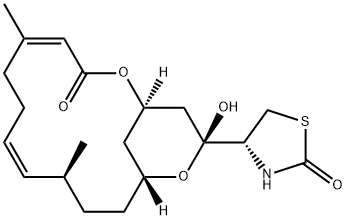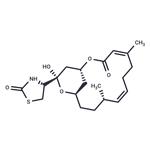Latrunculin B (76343-94-7) inhibits actin polymerization and disrupts microfilament organization.1 Significantly more potent than cytochalasins in the disruption of microfilament mediated processes2, causes shortening and thickening of stress fibers. Active in cell culture.3,4?Effective doses for latrunculin B vary depending upon cell type but are frequently in the low micromolar range. Note: Latrunculin B is slowly inactivated by fetal bovine serum.
Latrunculin B is an actin polymerization inhibitor.
Latrunculin B from Latruncula magnifica has been used for actin depolymerisation in various experiments. It has also been used as a component in bone marrow-derived dendritic cell (BMDC) complete medium, to study the formation of tubules from phagosomes in dendritic cells.
In elucidation of molecular mechanisms of motile processes.
ChEBI: A macrolide consisting of a 14-membered bicyclic lactone attached to the rare 2-thiazolidinone moiety. It is obtained from the Red Sea sponge Latrunculia magnifica.
Latrunculin B is a macrocyclic toxin, which is produced by Latruncula magnifica.
Primary TargetActin polymerization
1) Coue?et al. (1987),?Inhibition of actin polymerization by latrunculin; FEBS Lett.,?213?316
2) Spector?et al. (1989),?Latrunculins-novel marine macrolides that disrupt microfilament organization and affect cell growth; Cell Motil. Cytoskeleton,?13?127
3) Wakatsuki?et al. (2001),?Effects of cytochalasin D and latrunculin B on mechanical properties of cells; J. Cell. Sci.,?114?1025
4) Cha?et al. (2004),?The lateral mobility of NHE3 on the apical membrane of renal epithelial OK cells is limited by the PDZ domain proteins NHERF1/2 but is dependent on an intact actin cytoskeleton as determined by FRAP; Prog. Clin. Biol. Res.,?230 4
5) Herrera (2021), Cell cultures, transfection and treatments. protocols.io???https://dx.doi.org/10.17504/protocols.io.77ehrje [Focus Citation]

